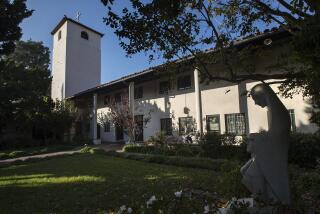A remote Irish island gets a ‘Star Wars’ rebranding — and not everybody’s happy about that
- Share via
Reporting from Mayo, Ireland — Sometime around AD 600, a handful of Irish monks decided that the rigors of fasting and penance on the mainland were not exacting enough.
Waiting until the seas were calm enough, they are believed to have rowed to Skellig Michael, a small, pyramid-shaped island seven miles off Ireland’s southwest coast. There, the holy men built a monastery and found the raw seclusion they were after.
A millennium and a half later, the site’s ruins are one of Ireland’s best-known heritage and tourist attractions, an antique allure made all the more vivid by the colonies of seabirds that flock to the island’s crags and crevices, and by the puffins and gulls sheltering in the monks’ long-abandoned stone structures.
But since 2015, some of those visitors are as likely to be dressed as Chewbacca and waving lightsabers as they are to be conversant in the ways of early Christian eremites or the nesting habits of kittiwakes or gannets. And that has some Irish conservationists worried.
“Star Wars” fans have been flocking to Skellig Michael because it was the location used for scenes on Ahch-To, the lost planet where Mark Hamill, aka Luke Skywalker, made his return to the “Star Wars” franchise at the end of 2015’s “The Force Awakens.”
Disney Lucasfilm returned to Ireland — and Skellig Michael — to film “The Last Jedi,” the latest “Star Wars” sequel.
Before 2015, the franchise seemed in danger of being as lost to history as early Christian asceticism. But the franchise’s awakening has prompted a jump in visitor numbers to Skellig Michael, in much the same way that “Lord of the Rings” created a boom for New Zealand’s tourist industry.
And though the 16,755 who this year made the boat journey from the mainland in County Kerry is a relatively small number — Ireland recorded 9.5 million visits in 2016, including 1.8 million from North America — it is enough to alarm preservationists.
Last week An Taisce, an Irish heritage preservation group, sent a letter to Ireland’s Minister for Arts, Heritage and Gaeltacht Josepha Madigan, asking her to intervene to preserve the island’s historical legacy, which An Taisce feels is threatened by a “Star Wars” “rebranding.”
The monks who came to Skellig Michael and their successors were “half-starved” and “crouched against gales high in the rocky cliffs,” according to Diarmaid MacCulloch’s “A History of Christianity.” Nevertheless, they managed to build a monastery near the island’s 715-foot summit, accessible by a rock and stone stairway carved around soaring cliffs overlooking the Atlantic.
That history led to Skellig Michael’s designation as a UNESCO World Heritage site. But conservationists now fear that the increased visitor numbers — previously capped at 11,100 in total for the May-October visiting months — could see the monastic ruins damaged and the island’s World Heritage status undermined.
“Like a virus, the imagery and branding of the Star Wars commercial franchise with all its plastic merchandising has contaminated and superseded the history and identity of the Skellig,” An Taisce declared in its letter to the minister.
Ireland’s heritage ministry said that Skellig Michael’s status as one of 1,073 UNESCO-listed sites -- alongside the likes of Yellowstone National Park, the Grand Canyon, Westminster Abbey, Vatican City and the Great Wall of China — is not under threat. Minister Madigan, a press officer said, “remains absolutely happy that all due and appropriate care was exercised at all times during the filmmaking.”
And Ireland’s tourism industry leaders say they are not undermining what playwright George Bernard Shaw called “the most fantastic and impossible rock in the world.”
“We are very conscious of Skellig Michael’s place in our history and culture,” said Alex Connolly, head of communications with Fáilte Ireland, the official tourism development agency.
“Only a certain amount of people can visit at a time and you can only visit when the waters are calm enough,” Connolly added, suggesting that visitor numbers can be easily managed.
Roughneen is a special correspondent.
More to Read
Sign up for Essential California
The most important California stories and recommendations in your inbox every morning.
You may occasionally receive promotional content from the Los Angeles Times.











